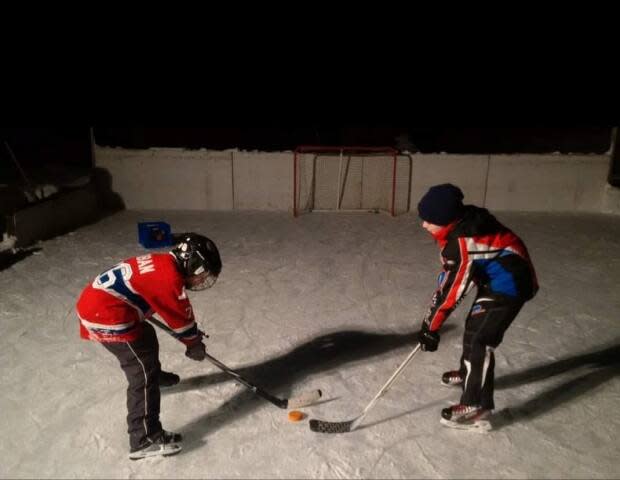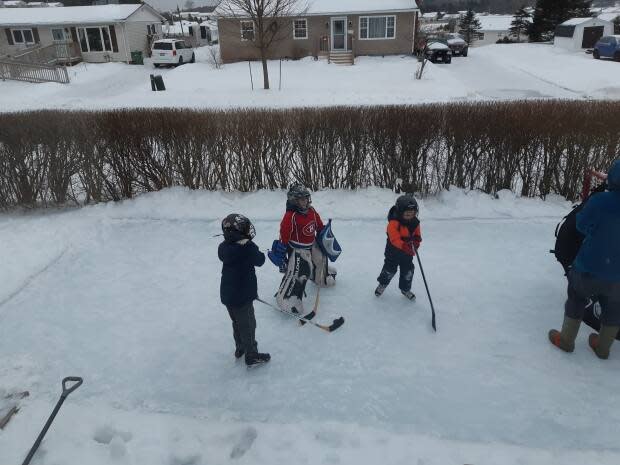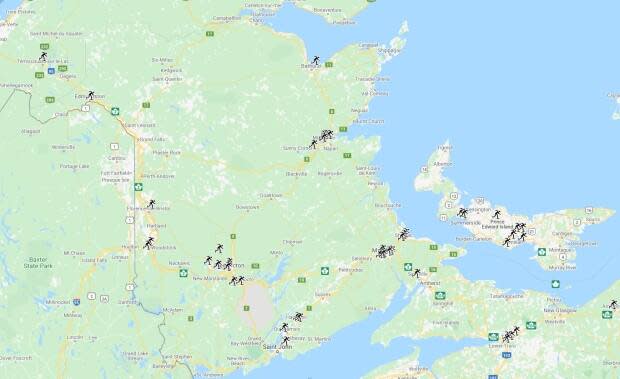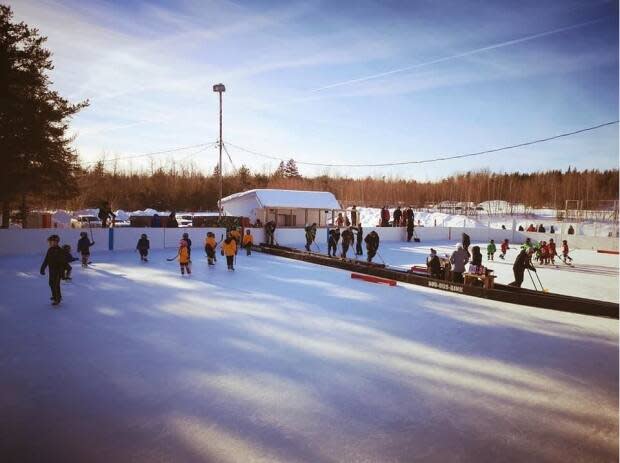Chasing 'that wintry feeling'
Some skating and hockey enthusiasts are expecting outdoor rinks to be very popular this winter because of the pandemic.
And climate researchers are looking to take advantage of that as they try to figure out what's in store for the planet and for the future of this cherished and time-honoured Canadian tradition.
"There's nothing like wet hands and damp feet," joked Michael Berube, who actually has very fond memories of backyard rink making at his home in Miramichi.
"For me, it's almost like therapy," he said.
"You go out and scrape the ice and it gives you that time to think."
"Some of the nights would be just beautiful," recalled Berube.
"It would be calm and cold and clear. I'd just stay out there for hours. It's quite peaceful."
Berube used to skate outdoors growing up in Campbellton and always wanted to have his own rink.
He built one for his three boys at their home in Miramichi from about 2005 to 2017.
The last year he made one it was 32x60 feet with boards all around it and nets at the ends to catch errant pucks.
His youngest son and several neighbourhood children used it often and a few other dads helped maintain it.
Berube said they "definitely had fun" and so did he.
It was nice to know where the kids were, he said, and to give them something active to do.

He admits it was "quite a bit of work."
"It's a thing of passion, I guess, when you get into it."
Environmental studies professor Robert McLeman of Wilfrid Laurier University shares that passion.
"We like skating and we like to figure out what's going on with the weather and our climate," said McLeman.
McLeman co-directs a group called Rink Watch.
For the past seven years, they've enlisted citizen scientists from across northern North America to report on daily skating conditions at outdoor rinks.
Berube was one of them.
McLeman and his research associate use the reports, together with historical weather data, to study long-term weather trends.
"The grandparents were not kidding when they said it was always snowing and cold," said McLeman.
"If you go back to the '40s and '50s," he said, "you can see the winters were much colder."
There were fewer "yo-yo-type days," when the temperature would swing widely up and down.
"Starting in the '80s and '90s, especially in eastern North America, you start to see a trend towards more variable winter weather conditions and not so many great skating days."

Depending on where you live in New Brunswick, the skating season typically starts in early or late December and ends sometime in early to mid-March.
But based on current trends, said McLeman, the outdoor skating season is likely to shrink by 25 to 35 per cent by the end of the century.
Berube said he noticed a change even during the relatively short span of time in which he kept rinks in Miramichi.
In the latter years, he said, it became more common to have mid-winter warm spells that would stretch for a few days.
Backyard rink makers had to adapt.
These days, "a liner is definitely a must," said Berube.
"So when you get those mild days you don't lose the water. It'll just refreeze."
It also doesn't leak into your basement, noted McLeman.
"In the old days," Berube said, "you just packed the snow and wet the snow and built up the ice."
Berube joined Rink Watch in about 2015.
Members had interesting discussions about climate change, he said.
"For example, the amount of dirt in the ice is the same thing you see going on in the Arctic as the ice retreats. The dirt in the snow attracts the heat."
That's something backyard rink operators understand well, he said.
"If you ever leave a black puck on the rink, the puck will sink. Within a couple of hours, the puck will go right through to the bottom to the liner. It draws that much heat -- a puck or a leaf or anything like that."
When there's lots of snow and ice, you can't see the fine particles of dirt, said Berube, but it's very evident when the rink starts melting.
That dirt is why your skates need sharpening more often when you skate outside, he noted.

Climate researchers and rink makers, it turns out, form a very natural alliance.
"You can ask any rink watcher," said Berube, "that's all we do is watch the forecast."
"It only takes small degrees to warm up and it totally changes what you get for ice."
Melting starts when daytime temperatures get up to minus 3 or 4, he said.
When he kept a rink, Berube said, he was on weather apps "nonstop," always wanting to know what the weather was going to do next.
"Is it raining first, then snowing? Snowing then raining? Freezing rain in between?"
These conditions all require different approaches to rink maintenance, said Berube.
"You've got to know whether you leave it, scrape it, add to it. And you're always trying to guess when that changeover is going to be."
If you make the wrong call, he said, you end up with a mess.
"I made a few booboos early on. There's quite the knack to it."
A few first-time rink builders have asked Berube for advice this fall.
They have decided to get into rink making to make sure their kids have a place to skate, he said, in case hockey season is suddenly called off and arenas shut down because of an outbreak.
That's a big factor for Ashley Nickerson, of west Saint John.
"The need is even greater to have a place where they can get out and play," she said.

Nickerson has two children, aged 7 and 9. They play on a community hockey team, she said, and many of their teammates live nearby.
She built her first rink three winters ago using garden bricks and a cheap tarp she found in her garage.
This year, with the help of her husband, sister and step-dad, she graduated to a 20x50-foot playing surface with two-foot plywood boards around the perimeter. The liner just arrived in the mail this week.
"It looks pretty official," she said.
"We're just waiting for the cold weather to fill it up."
Maintaining the rink is a lot of work, agreed Nickerson, but she finds it worthwhile, "just to see the kids out enjoying it."
Like Berube, she has also developed an obsession with the weather.
"You see rain and sleet coming and you're like, 'Oh, no! Because you know you're going to be out there in the middle of the night trying to get it off before it settles."
"Yeah, I've been out there at 1 o'clock in the morning flooding it."
"So fun," she said facetiously.
You have to stay on top of it, she said, if you don't want all the work you've already put in to go to waste.
Nickerson joined an online community of rink makers for tips and said she intends to join Rink Watch this winter.
She is interested to see all the rink data that's being compiled from across the continent.

McLeman is thrilled at the prospect of more backyard rink makers joining his network.
"There are lots of pros in New Brunswick," said McLeman.
He's hoping to get a few more new members around the province.
Anyone interested can find information at rinkwatch.org. They also have Facebook and Twitter pages.
In return for their participation, Rink Watchers receive an annual report that includes information about temperatures, precipitation and skating conditions over the season at other member rinks.
A number of New Brunswick rink makers have submitted information to the program sporadically since 2013, he said, but last year Rink Watch started a more regular surveillance program called Sentinels.
A group in Miramichi was the only one that took part.
"I think it's really neat," said Melissa White, one of several people who've been involved in reviving the rink at the Nordin Recreation Centre, in the northern part of the city.

White skated there as a child, but it hadn't operated in about two decades before a group of parents got it going again in 2017.
A handful of people take care of the ice on a regular basis, said White, adding the group would love to have more volunteers.
Any given Saturday that the Nordin rink operated last winter, about 100 people used it, she said.
"It's nice to see everybody using it."
"I think they just love it."
"Everybody kind of gets that wintry feeling."
It's not the same as skating at an indoor arena, said White, and younger and older hockey players have a chance to play together.
White isn't sure whether the Nordin rink will open this year.
There are concerns about its unstaffed warming hut and the requirements for COVID-19 prevention and contact tracing.
They're talking about it, she said, with public health officials.


